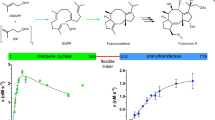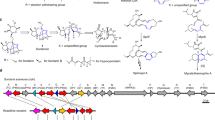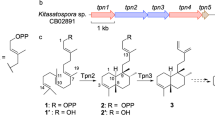Abstract
Trt14 from Aspergillus terreus is involved in unusual skeletal reconstruction during the biosynthesis of the fungal meroterpenoid terretonin. Detailed in vitro characterization revealed that this novel multifunctional enzyme catalyzes not only the D-ring expansion via intramolecular methoxy rearrangement, but also the hydrolysis of the expanded D-ring. The X-ray crystal structures of Trt14, in complex with substrate or product, and two Trt14 homologs, AusH and PrhC from Aspergillus nidulans and Penicillium brasilianum, respectively, indicated similar overall structures to those of the NTF2-like superfamily of enzymes, despite lacking sequence and functional similarities. Moreover, we gained structural insight into the mechanism of the Trt14-catalyzed ring reconstruction from the in-crystal enzyme reaction and site-directed mutagenesis to show that this reaction involves sequential ester bond cleavage and formation. Structural comparison of Trt14 and its homologs suggests that the enzymes in this new superfamily employ similar acid–base chemistry to diversify the molecular architecture of fungal meroterpenoids.
This is a preview of subscription content, access via your institution
Access options
Access Nature and 54 other Nature Portfolio journals
Get Nature+, our best-value online-access subscription
$29.99 / 30 days
cancel any time
Subscribe to this journal
Receive 12 print issues and online access
$259.00 per year
only $21.58 per issue
Buy this article
- Purchase on Springer Link
- Instant access to full article PDF
Prices may be subject to local taxes which are calculated during checkout






Similar content being viewed by others
References
Geris, R. & Simpson, T.J. Meroterpenoids produced by fungi. Nat. Prod. Rep. 26, 1063–1094 (2009).
Matsuda, Y. & Abe, I. Biosynthesis of fungal meroterpenoids. Nat. Prod. Rep. 33, 26–53 (2016).
Sintchak, M.D. et al. Structure and mechanism of inosine monophosphate dehydrogenase in complex with the immunosuppressant mycophenolic acid. Cell 85, 921–930 (1996).
McCowen, M.C., Callender, M.E. & Lawlis, J.F. Fumagillin (H-3), a new antibiotic with amebicidal properties. Science 113, 202–203 (1951).
Tomoda, H. et al. Relative and Absolute stereochemistry of pyripyropene A, a potent, bioavailable inhibitor of acyl-CoA:cholesterol acyltransferase (ACAT). J. Am. Chem. Soc. 116, 12097–12098 (1994).
Minagawa, N. et al. An antibiotic, ascofuranone, specifically inhibits respiration and in vitro growth of long slender bloodstream forms of Trypanosoma brucei brucei. Mol. Biochem. Parasitol. 81, 127–136 (1996).
Lo, H.C. et al. Two separate gene clusters encode the biosynthetic pathway for the meroterpenoids austinol and dehydroaustinol in Aspergillus nidulans. J. Am. Chem. Soc. 134, 4709–4720 (2012).
Matsuda, Y., Awakawa, T., Wakimoto, T. & Abe, I. Spiro-ring formation is catalyzed by a multifunctional dioxygenase in austinol biosynthesis. J. Am. Chem. Soc. 135, 10962–10965 (2013).
Guo, C.-J. et al. Molecular genetic characterization of a cluster in A. terreus for biosynthesis of the meroterpenoid terretonin. Org. Lett. 14, 5684–5687 (2012).
Matsuda, Y., Iwabuchi, T., Wakimoto, T., Awakawa, T. & Abe, I. Uncovering the unusual D-ring construction in terretonin biosynthesis by collaboration of a multifunctional cytochrome P450 and a unique isomerase. J. Am. Chem. Soc. 137, 3393–3401 (2015).
Matsuda, Y., Awakawa, T. & Abe, I. Reconstituted biosynthesis of fungal meroterpenoid andrastin A. Tetrahedron 69, 8199–8204 (2013).
Matsuda, Y., Wakimoto, T., Mori, T., Awakawa, T. & Abe, I. Complete biosynthetic pathway of anditomin: nature's sophisticated synthetic route to a complex fungal meroterpenoid. J. Am. Chem. Soc. 136, 15326–15336 (2014).
Matsuda, Y. et al. Discovery of key dioxygenases that diverged the paraherquonin and acetoxydehydroaustin pathways in Penicillium brasilianum. J. Am. Chem. Soc. 138, 12671–12677 (2016).
Matsuda, Y., Awakawa, T., Mori, T. & Abe, I. Unusual chemistries in fungal meroterpenoid biosynthesis. Curr. Opin. Chem. Biol. 31, 1–7 (2016).
Fukuda, T., Kurihara, Y., Kanamoto, A. & Tomoda, H. Terretonin G, a new sesterterpenoid antibiotic from marine-derived Aspergillus sp. OPMF00272. J. Antibiot. (Tokyo) 67, 593–595 (2014).
Eberhardt, R.Y. et al. Filling out the structural map of the NTF2-like superfamily. BMC Bioinformatics 14, 327 (2013).
Murzin, A.G. Structural classification of proteins: new superfamilies. Curr. Opin. Struct. Biol. 6, 386–394 (1996).
Arand, M. et al. Structure of Rhodococcus erythropolis limonene-1,2-epoxide hydrolase reveals a novel active site. EMBO J. 22, 2583–2592 (2003).
Johansson, P. et al. Structure of an atypical epoxide hydrolase from Mycobacterium tuberculosis gives insights into its function. J. Mol. Biol. 351, 1048–1056 (2005).
Lundqvist, T. et al. Crystal structure of scytalone dehydratase—a disease determinant of the rice pathogen, Magnaporthe grisea. Structure 2, 937–944 (1994).
Sultana, A. et al. Structure of the polyketide cyclase SnoaL reveals a novel mechanism for enzymatic aldol condensation. EMBO J. 23, 1911–1921 (2004).
Cho, H.S. et al. Crystal structure of delta(5)-3-ketosteroid isomerase from Pseudomonas testosteroni in complex with equilenin settles the correct hydrogen bonding scheme for transition state stabilization. J. Biol. Chem. 274, 32863–32868 (1999).
Hasegawa, H. & Holm, L. Advances and pitfalls of protein structural alignment. Curr. Opin. Struct. Biol. 19, 341–348 (2009).
Holm, L. & Rosenström, P. Dali server: conservation mapping in 3D. Nucleic Acids Res. 38, W545–W549 (2010).
Minami, A. et al. Allosteric regulation of epoxide opening cascades by a pair of epoxide hydrolases in monensin biosynthesis. ACS Chem. Biol. 9, 562–569 (2014).
Hotta, K. et al. Enzymatic catalysis of anti-Baldwin ring closure in polyether biosynthesis. Nature 483, 355–358 (2012).
Minami, A. et al. Enzymatic epoxide-opening cascades catalyzed by a pair of epoxide hydrolases in the ionophore polyether biosynthesis. Org. Lett. 13, 1638–1641 (2011).
Rice, L.M., Earnest, T.N. & Brunger, A.T. Single-wavelength anomalous diffraction phasing revisited. Acta Crystallogr. D Biol. Crystallogr. 56, 1413–1420 (2000).
Kabsch, W. Xds. Acta Crystallogr. D Biol. Crystallogr. 66, 125–132 (2010).
Terwilliger, T.C. et al. Decision-making in structure solution using Bayesian estimates of map quality: the PHENIX AutoSol wizard. Acta Crystallogr. D Biol. Crystallogr. 65, 582–601 (2009).
Adams, P.D. et al. PHENIX: a comprehensive Python-based system for macromolecular structure solution. Acta Crystallogr. D Biol. Crystallogr. 66, 213–221 (2010).
Terwilliger, T.C. et al. Iterative model building, structure refinement and density modification with the PHENIX AutoBuild wizard. Acta Crystallogr. D Biol. Crystallogr. 64, 61–69 (2008).
Emsley, P. & Cowtan, K. Coot: model-building tools for molecular graphics. Acta Crystallogr. D Biol. Crystallogr. 60, 2126–2132 (2004).
Afonine, P.V. et al. Towards automated crystallographic structure refinement with phenix.refine. Acta Crystallogr. D Biol. Crystallogr. 68, 352–367 (2012).
McCoy, A.J. et al. Phaser crystallographic software. J. Appl. Crystallogr. 40, 658–674 (2007).
Acknowledgements
We thank H. Nakamura (The University of Tokyo) for critical reading of the manuscript. This work was supported in part by a Grant-in-Aid for Scientific Research from the Ministry of Education, Culture, Sports, Science and Technology, Japan (JSPS KAKENHI Grant Number JP15H01836 and JP16H06443 to I.A.). The synchrotron radiation experiments were performed at the BL41XU of SPring-8, BL-17A, NE3A, and NW12A of the Photon Factory with proposal No. 2015B2031 and 2015G530, respectively.
Author information
Authors and Affiliations
Contributions
T.M. and I.A. designed the experiments. T.M. expressed, purified, crystallized, and solved the structure of the protein, and performed in vitro experiments. T.I. designed constructs and cloned, expressed, and purified protein, and performed in vivo experiments. S.H. determined the structure of compounds. H.W. expressed, and purified, and crystallized protein. T.M., Y.M., and I.A. analyzed the data. T.M. and I.A. wrote the paper.
Corresponding author
Ethics declarations
Competing interests
The authors declare no competing financial interests.
Supplementary information
Supplementary Text and Figures
Supplementary Results, Supplementary Tables 1–2 and Supplementary Figures 1–12. (PDF 10866 kb)
Supplementary Note 1
Characterization of Chemical Compounds. (PDF 10989 kb)
Rights and permissions
About this article
Cite this article
Mori, T., Iwabuchi, T., Hoshino, S. et al. Molecular basis for the unusual ring reconstruction in fungal meroterpenoid biogenesis. Nat Chem Biol 13, 1066–1073 (2017). https://doi.org/10.1038/nchembio.2443
Received:
Accepted:
Published:
Issue Date:
DOI: https://doi.org/10.1038/nchembio.2443
This article is cited by
-
Peculiarities of meroterpenoids and their bioproduction
Applied Microbiology and Biotechnology (2021)
-
Fungal-derived brevianamide assembly by a stereoselective semipinacolase
Nature Catalysis (2020)
-
Enzyme-catalysed [6+4] cycloadditions in the biosynthesis of natural products
Nature (2019)



